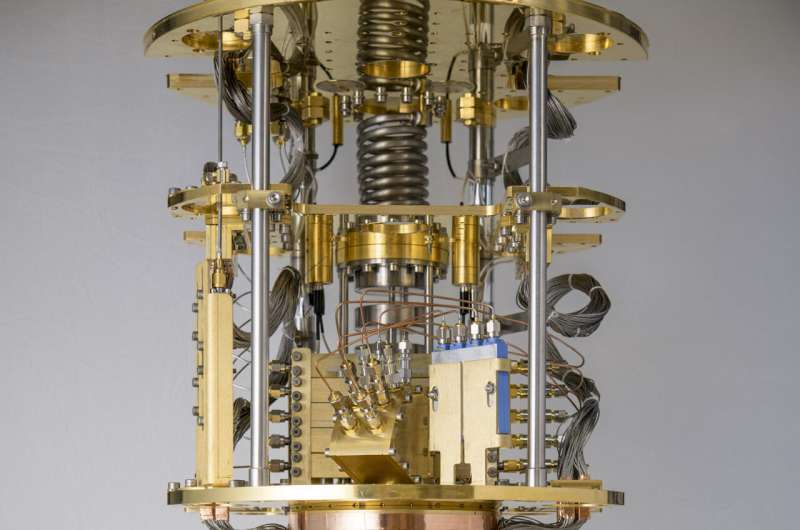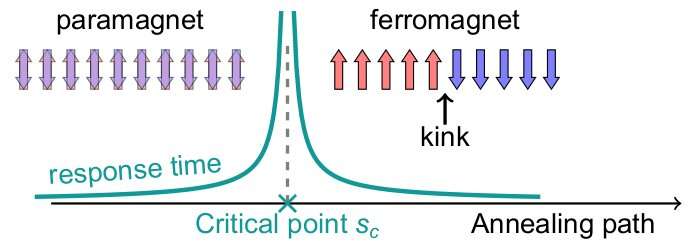October 10, 2022 feature
The coherent simulation of a quantum phase transition in a programmable 2,000 qubit Ising chain

Quantum computers have the potential to outperform classical computers on several complex tasks, yet many challenges will need to be overcome before they reach their full potential. In the meantime, physicists and computer scientists have been trying to realistically estimate the capabilities that quantum computing technologies will exhibit in the near future.
Quantum simulations—realizations of quantum systems manifested using programmable simulation devices—have proved particularly valuable for determining the near-term potential of quantum computers. One approach that can be investigated using quantum simulations is quantum annealing, an optimization process based on engineered quantum fluctuations.
Researchers at D-Wave Systems and various institutes in Canada, the U.S. and Japan have recently simulated a quantum phase transition in a programmable 2,000 qubit 1D quantum Ising model. Their results, presented in a paper published in Nature Physics, could inform future quantum optimization and simulation efforts.
"Coherent annealing has been something we've wanted to showcase for a long time," Andrew D. King, one of the researchers who carried out the study, told Phys.org. "One reason is that it allows us to compare the behavior of our programmable quantum system with ideal Schrödinger dynamics, providing both strong evidence of quantum-ness and a benchmark of this quantum-ness. The 1D chain is perfect for this because it has a well-known closed-form solution, which means that we can solve it classically without exhaustively simulating the quantum dynamics—a classically intractable task in general."
The quantum simulation of the 1D Ising chain has been done before by other research teams, including a group at Harvard University. However, the simulation carried out by King and his colleagues is the first to be conducted using an annealing-based quantum computer. In addition, the researchers were able to realize larger and more strongly correlated states than those demonstrated in the past.

"The key variable here in our experiment is the annealing time, which is the time the D-Wave processor takes to go from its initial quantum superposition state to the classical endpoint of the computation," King explained. "Normally a speed limit of 500 nanoseconds is placed on the system, to allow tolerances on the control circuitry. In this work, however, we went 100 times faster than this."
Due to the higher speeds reached by their system, King and his colleagues had to apply more stringent hardware requirements and use new software methods. This ultimately allowed them to perfectly synchronize the thousands of qubits in their system.
The researchers performed their simulations using a highly programmable processor created at D-Wave Systems. To test its effectiveness more reliably, they chose to simulate an extremely simple and well understood quantum phase transition.
"The excellent agreement we see between the experiments and the ideal quantum model with no environmental effects is a new development in the field of quantum annealing," King said. "It shows us not only that the system is manifestly quantum, but that we can program more complex systems into the quantum annealer and expect it to follow the true quantum dynamics of the Schrödinger equation, which in general cannot be simulated classically."
Overall, the team found that their simulations were aligned with predictions of quantum theory. In the future, their work could open new and exciting possibilities for the study of different quantum phase transitions. In their next works, King and his colleagues would like to use programmable D-Wave processors to simulate more exotic quantum phase transitions, which cannot be simulated using classical computers.
"Most people want to use quantum annealing either for quantum simulation, which we have done here, or for optimization," King added. "The textbook quantum phase transition that we studied in this work is only indirectly applicable to optimization, so it's important to tie these two areas together. We already know that quantum annealers can solve optimization problems very quickly. Our next job will be to study this success using coherent annealing, to explain in detail the role of quantum critical dynamics in quantum annealing optimization."
More information: Andrew D. King et al, Coherent quantum annealing in a programmable 2,000 qubit Ising chain, Nature Physics (2022). DOI: 10.1038/s41567-022-01741-6
Jacek Dziarmaga, Dynamics of a Quantum Phase Transition: Exact Solution of the Quantum Ising Model, Physical Review Letters (2005). DOI: 10.1103/PhysRevLett.95.245701
Alexander Keesling et al, Quantum Kibble–Zurek mechanism and critical dynamics on a programmable Rydberg simulator, Nature (2019). DOI: 10.1038/s41586-019-1070-1
Journal information: Nature , Nature Physics , Physical Review Letters
© 2022 Science X Network




















